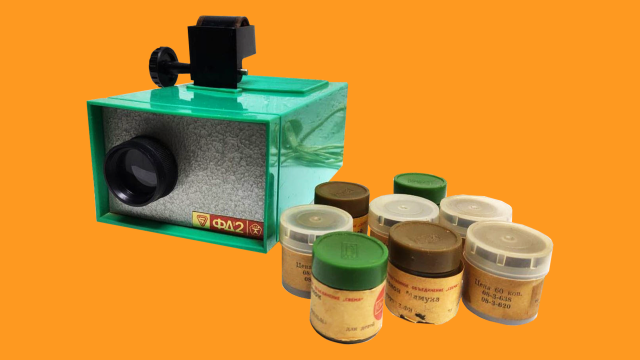By the time I was born in 1987, the filmstrip projector was already vintage: a musty, overheating box with a brittle lightbulb glowing yellow out of the vent. For the Soviet Union public, the once widely popular tech could not compete with VHS, but I was not interested in VHS. I preferred to hole up in the dark with the rickety Diafilm projector whenever I could negotiate some privacy in the two-room apartment our family of four shared, curtains drawn.
I’d make a fort out of sheets and my brother’s sofa/bed cushions (blocky, partially velvet, striped burnt orange and yellow) and lay on the floor (brown linoleum, tattered rug with a fringe, I think?) and sulk and point the projector at the ceiling. I would turn the squeaky dial to scroll through storybook slides, 20-50 slides per reel. I’d read the captions to myself aloud, do character voices. Princess Vasselisa (or was it the Frog Princess?). Magical swans, little pigs. The bad wolf man who perpetually pursued a rabbit boy, presumably to eat him, in a Soviet humanoid animal universe where no other predator seemed interested in such criminal activity.
I clutch to every specific detail I think I remember because I’m fishing through the fog. I remember fidgeting wildly but finally mastering wedging the tip of the metre-long 35mm film strip into the external rig, clipping the sprocket holes in place, pulling back the whizzing lever with my stubby kid fingers. It clicked. It hummed. It once emitted smoke, or maybe I dreamt that.
We were not on the bleeding edge of consumer technology. Whenever people see photos of me as a child, they assume it’s one of my parents or older, the sepia and drained pink hues or grainy black and white signalling photo tech older than the ‘90s when those photos were taken. My family liked old gadgets, or more likely that’s all we could access or afford at the time, causing a kind of aesthetic delay. I didn’t mind outdated tech. That was not a concept I understood at the time.
Diafilm studio was founded in Moscow in 1930 and produced the majority of the filmstrips. The studio mostly produced cartoons, educational PSAs, and social propaganda that leaned occasionally sci-fi. At the height of popularity in the ‘70s and ‘80s, colour strips went for 30 kopecs a pop and black and white for 20, when you could buy a bus ticket for 5. Some came with accompanying tape reels with cues to change slides for the full audiovisual experience, but I didn’t use those. As it was, it was a relatively affordable form of entertainment, and for my parents, a great way to keep me occupied with a silent piece of media so I’d have to “use my imagination” and mutter to myself for hours.
I liked the limitations, the separation of sound and picture. I liked reading to myself. I felt autonomous. I could lug that projector all over the apartment looking for my own corner, unlike the one bloated TV. I liked my storybooks on vinyl too, played in a dark room or with eyes closed, immersive that way, the actors’ voices and folly effects bouncing in my head. I still like outmoded tech — not for some purist ideals, but firmly for my own personal nostalgia.
The truth is that I hoard, occasionally, Soviet tech and other things — Zenit and Lubitel 2 cameras, one ‘70s wind-up clock nested in deep orange resin, my recently passed grandparents’ medals.
Diafilm stopped producing filmstrips in 1993, but China and Belarus are making comparable products under different brand names. You can still find Diafilm projectors and filmstrips — packed into their colourful plastic canisters with sometimes hand-written labels — on Etsy and eBay, if you don’t mind hefty international shipping rates from Ukraine and Russia and the mysterious shipping times that rely on some of the most unreliable postal services in the world. I’m eagerly awaiting my package.
I’ve been accumulating these relics occasionally through the years when I feel like splurging to indulge an absolutely irrational desire to reconstruct the echos of very specific childhood experiences, at three in the morning after a sleepless night, sitting at my computer in the living room, fidgeting to tinker with something, in the dark, curtains drawn.
